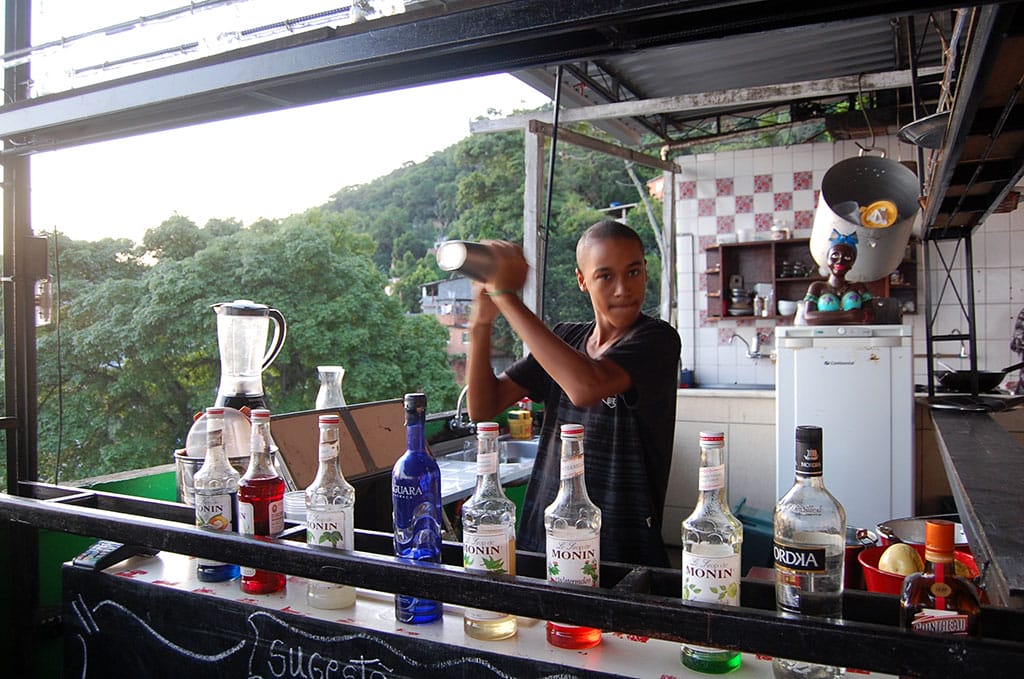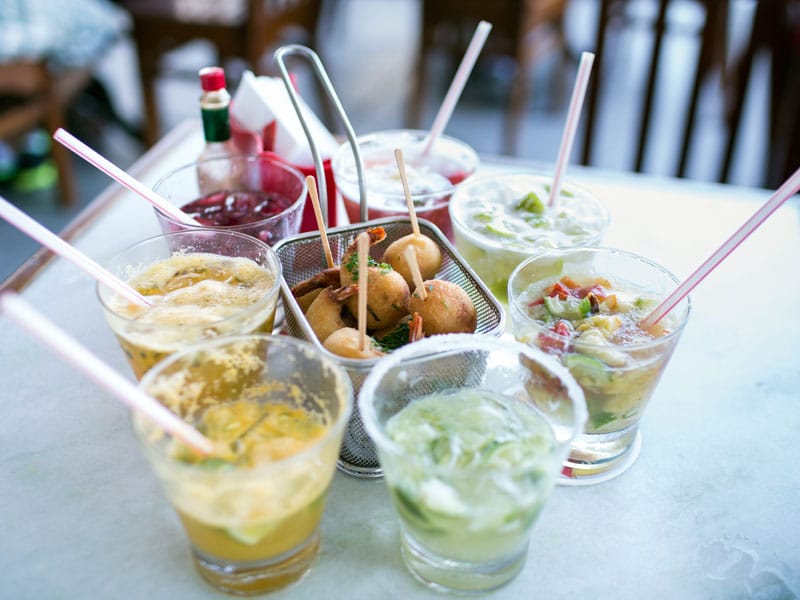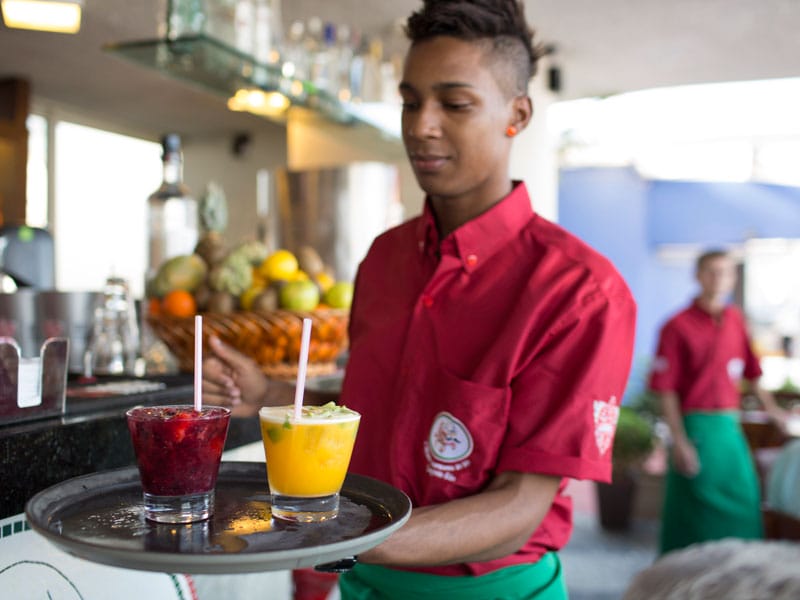You get to Bar do Alto by taking a zippy mototaxi up the snaking streets of the Babilônia favela and then walking 10 minutes up jagged staircases that eventually bear right. On the route, you’ll pass by slices of life that make favelas a museum of Rio, where the city’s symbols and icons are on display in the bare and human way that’s made possible by close quarters of self-made dwellings. There are the evangelicals raising their voices in weeknight prayers. Shirtless men with leathered skin that speaks to long day jobs, now tipping back tall evening bottles of beer. Children playing soccer as overheated cops in bulletproof vests slump on nearby benches.
You’ll work up a sweat on those stairs to get to the Zerbinato home. When you arrive on their lage (“LAH-jeey”) – anywhere else in the city, an open space on the top floor of a building is called a terrace or cobertura, but in favelas, it’s a lage – you’ll watch the slow stream of lights make their way through the packed Copacabana traffic down below as the sun sets into shades of mauve. This view tells you the story of why favelas exist: These are Rio’s affordable housing solutions for the working class. The city needed doormen, maids and janitors as its posh South Zone boomed, but it didn’t have accessible places to house them. The steep, precarious hillsides behind those beachside neighborhoods provided an answer.
Rubens Zerbinato, 34, is a part of that story. Born and raised in Babilônia, one of two favelas barely visible from the Leme beach – the high-rises block them from a pedestrian’s view – he long lived a life between the morro (hill) and the asfalto (the asphalted neighborhoods down below). He took a technical course in tourism, but he was too shy to lead groups of visitors. He loved cooking for his family, however, and his relatives thought he was good at it, so he threw his resume all around the South Zone, finding work in a series of hotels, restaurants and malls. After starting out as a dishwasher in Ipanema, he eventually rose to the rank of head chef at the Marina Hotel in Leblon.
But when Rubens came back to his own lage, where his uncle César was a neighborhood favorite for throwing feijoadas (Brazil’s national dish, a rich black bean stew with pork – though the word feijoada both refers to the dish and the music and alcohol-filled weekend parties that usually surround it), he felt a certain sadness about trudging downward each day when his home had its own beauty. “I looked here and said: Why am I here alone?” he recalled. Following the spirit of his uncle, at the beginning of 2014, he opened Bar do Alto, or “the Bar at the Top.”
Bar do Alto has a vibe – Brazilians say “VIE-beey,” and it means ambiance or scene – that’s equal parts family lage and hard-partying youth hostel. The strobe light would feel disorienting on a weekday night if it weren’t for the lush 180-degree view of forest and residential life on display from the terrace.  The technicolor drinks make for superb selfie-taking – the capichopp, a caipirinha with a shot of apple flavoring, is as green as a Rio forest after a rainy day. Rubens’s most inventive beverage is champagne with the deeply purple açaí berry mixed in.
The technicolor drinks make for superb selfie-taking – the capichopp, a caipirinha with a shot of apple flavoring, is as green as a Rio forest after a rainy day. Rubens’s most inventive beverage is champagne with the deeply purple açaí berry mixed in.
Rubens’s dishes are a series of rich Brazilian favorites with contemporary touches picked up in his years working in hospitality – shrimp stew, crispy fried squid, filet mignon with the solid white cheese queijo coalho, beloved by northeastern migrants and Rio partiers alike, the latter eating it on skewers sold by street vendors late into the night. His most popular is his harumaki com feijoada, essentially a spring roll filled with Brazil’s favorite beans. We were delighted to find that our nicely seasoned moqueca coconut stew with bell peppers and shiitake mushrooms came topped with crunchy alfalfa, an alien ingredient on the Brazilian bar food scene.
With his taut biceps and backward baseball cap, Rubens could be just another carioca bro on the beach. But watch him in his element and you can appreciate how enthusiastic he is to be back home and cooking for guests and neighbors. With boyish enthusiasm, he shows off a foreign taste he picked up while working in a café: barbecue sauce. He makes a point not to work late hours, so the senhoras (elderly lady neighbors) around him can rest – Rubens himself sleeps below this lage – and he has become a neighborhood big brother figure. During our meal time, three children streamed into his restaurant asking for money and looking for a place to play, requests Rubens happily obliged.
And that tourism course? In a twist, it’s now Rubens who is doing the hiring. In addition to his local employees, he has a Lebanese hostess, a Peruvian bartender and an Argentine cook, members of a new generation of migrants who have come to Rio looking to start a new life. In their case, work can now be found not just down in the asfalto, but also up in the morro.
 August 8, 2016 Quiosque do Português
August 8, 2016 Quiosque do Português
It might have become one of the more fashionable places in Rio for a caipirinha, yet the […] Posted in Rio July 10, 2013 Quiosque do Português
July 10, 2013 Quiosque do Português
It might have become one of the more fashionable places in Rio for a caipirinha, yet the […] Posted in Rio May 31, 2013 Raising Cane: Cachaça’s New Day
May 31, 2013 Raising Cane: Cachaça’s New Day
To call someone a cachaceiro in Brazil is to deal a pretty low Portuguese blow. The word […] Posted in Rio
Published on January 13, 2016
Related stories
August 8, 2016
RioIt might have become one of the more fashionable places in Rio for a caipirinha, yet the name of this father-son joint – “Portuguese Kiosk” – suggests humility. Indeed, the pair got their start a decade ago in one of the numerous huts that line the city’s beaches. While the majority of their competitors served…
July 10, 2013
RioIt might have become one of the more fashionable places in Rio for a caipirinha, yet the name of this father-son joint – “Portuguese Kiosk” – suggests humility. Indeed, the pair got their start a decade ago in one of the numerous huts that line the city’s beaches. While the majority of their competitors served…
May 31, 2013
RioTo call someone a cachaceiro in Brazil is to deal a pretty low Portuguese blow. The word translates roughly to “drunkard” and evokes the image of an unkempt alcoholic clutching a plastic bottle of the powerful local liquor known as cachaça. It’s no coincidence that the name of the drink made with cachaça, the caipirinha,…
















































































